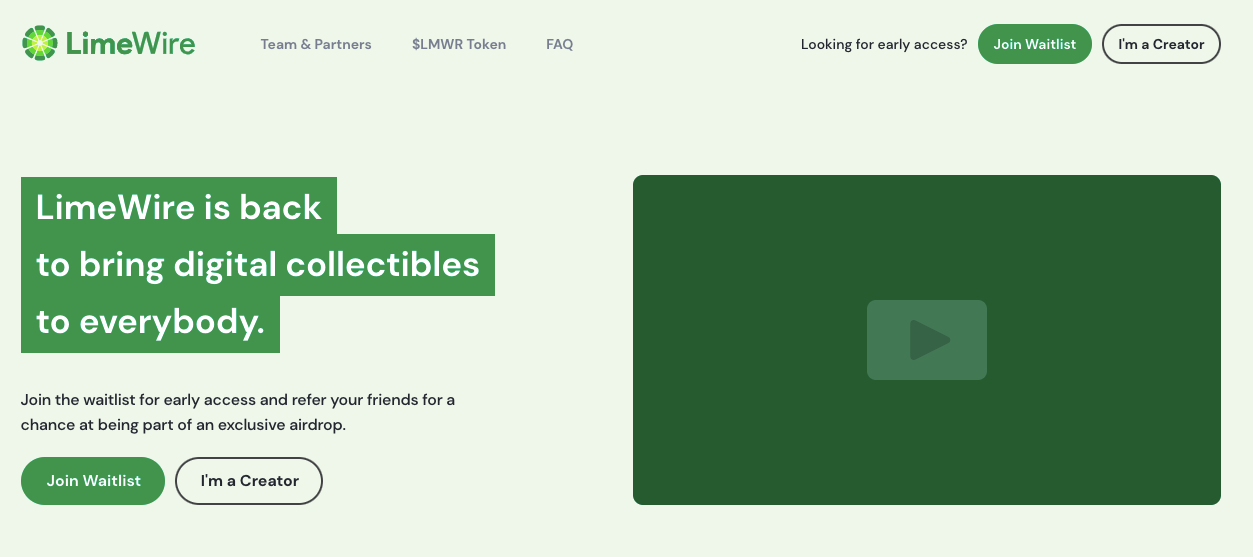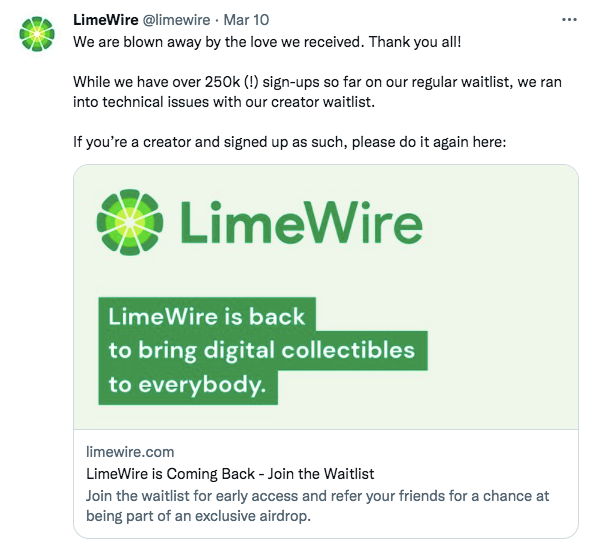Limewire holds a special place in the hearts of most early noughties internet users. After its launch in 2000, the file sharing platform became the biggest in the world, giving people free access to music, films and TV shows. It was also rife with piracy, highly illegal sharing and enough malware to decimate the average family computer. Limewire was eventually shut down in 2011 after it was sued by record labels but now it’s set to make a return as a brand new NFT marketplace.

From Web2 to Web3
There aren’t many early Web2 users who didn’t at least dabble with Limewire, possibly running afoul of a pc-ruining virus in the process. Although Limewire has gradually transformed into a meme over the years, it played an important role in the digital revolution and paved the way for legal streaming services like Spotify and even YouTube. It showed millions of people the potential of digital music downloads in a time when that wasn’t the norm. It also raised important (and in many ways still unanswered questions) about how musicians should be paid for digital downloads and streams.
The platform itself is long dead, but brothers Paul and Julian Zehetmayr have acquired the rights and now plan to resurrect the brand in Web3. A new Limewire marketplace will launch in May. It will focus on music to begin with before expanding into art and other forms of entertainment. Limewire will eventually get its own NFT token reward system as it seeks to build long lasting infrastructure. Not bad for a brand name that’s been dead for the last 12 years.
The brothers plan to scale up rapidly, bringing millions of new artists on board in the first year. The marketplace will be a curated and moderated platform designed to support everyone from emerging musicians to big industry names. Partnerships with industry specialists and established artists virtually ensure that it will make a big splash when it launches. As well as songs, users will also be able to collect live tracks, digital merchandise, backstage content, demos and much more.

A Fairer Deal
Given Limewire’s dubious reputation, it might come as a surprise to learn that the new marketplace puts fairness at the heart of its agenda. The brothers are intent on righting the wrongs of the past and making sure that artists get a fair deal. Up to 90% of all proceeds will go directly to creators. Those artists will also have a say in how the platform is run. The team released a statement claiming that they’ll work with creators to ensure that they always retain full ownership of their work and are paid fairly.
That represents a dramatic and nearly unbelievable shift for the Limewire brand. Mark Gorton, founder of the original platform, was eventually forced to pay $105 million in damages to record labels accusing him of copyright infringement. Limewire certainly has a problematic past, but modern day streaming services aren’t necessarily much better. Artists often struggle to make a living and are paid a pittance for their work. Smaller musicians are hit the hardest and many simply fade out of the industry.
One of the frequently touted benefits of NFTs is that they give artists a better deal, cutting out middlemen and helping them to retain ownership of their work. If Limewire, probably the biggest pirate platform ever, can be reborn as a true artist’s marketplace then we might just be witnessing internet history in the making.
Enticing New Users
It’s easy to roll your eyes at the thought of yet another NFT marketplace but LimeWire has a few tricks up its sleeve that will help it stand out from the crowd. The brothers plan to focus on simplicity and accessibility. Prices will be listed in USD as well as crypto and the marketplace will be aimed at music lovers, not just people interested in NFTs. Throw in a heady dose of nostalgia and Limewire could well entice crypto newbies into the NFT world.
Paul acknowledges that, while NFTs are gaining traction, they’re still “really limited to a small group of savvy users” and the entry barrier remains too high for many. Limewire aims to remedy this problem and help NFTs take another stride along the path towards mass adoption. If it manages to accomplish this while guaranteeing a better deal for artists, then there’s every chance that the new Limewire will be just as big a cultural phenomenon as the old one.


